He wanted to join the Marines, but he was too short. The paratroopers wouldn’t have him either. Reluctantly, he settled on the infantry, enlisting to become nothing less than one of the most-decorated heroes of World War II. He was Audie Murphy, the baby-faced Texas farm boy who became an American Legend.
Biography of Audie Murphy
The sixth of twelve children, Audie Murphy, was born in Kingston, Hunt County, TX, on June 20, 1925. The son of poor sharecroppers, Emmett and Josie Murphy, Audie grew up on a rundown farm and attended school in Celeste. His education was cut short in 1936 when his father abandoned the family. Left with only a fifth-grade education, Murphy began working on local farms as a laborer to help support his family. A gifted hunter, he was also able to feed his siblings from game animals he shot.

Though he attempted to support the family on his own by working various jobs, Murphy was ultimately forced to place his three youngest siblings in an orphanage when their mother died in May 1941. This was done with the blessing of his older, married sister Corrine. Long believing that the military offered a chance to escape poverty, he attempted to enlist following the Japanese attack on Pearl Harbor. As he was only 16 years old, he was rejected for being underage. Six months later, in June 1942, shortly after his seventeenth birthday, Corrine adjusted Murphy’s birth certificate to make it appear that he was eighteen.
Audie Murphy was Rejected Due to His Small Stature (5’5 “, 110 lbs.)
He first went to a U.S. Marine Corps recruiting office but was rejected due to his small stature (5’5″, 110 lbs.). Next, he tried the U.S. Army Airborne but was again rejected. He was similarly rejected by the U.S. Navy. Pressing on, he ultimately achieved success with the U.S. Army and enlisted at Greenville, TX. on June 30, 1942. Ordered to Camp Wolters, TX., Murphy began basic training. Murphy completed basic training and transferred to Fort Meade, MD, for infantry training.
Finishing his infantry training, Murphy was assigned to 3rd Platoon, Baker Company, 1st Battalion 15th Infantry Regiment 3rd Infantry Division in Casablanca, Morocco. Arriving in early 1943, he began training for the invasion of Sicily.

Five Days Later, Audie Murphy was Promoted to Corporal
On July 10, 1943, the division made an assault landing on Sicily at a beach town called Licata. In one of the initial contacts, Murphy used his marksmanship skills to kill two Italian Officers attempting to escape on horseback. Five days later, he was promoted to Corporal. Over the coming weeks, the 3rd Infantry Division fought its way into Palermo and raced on to capture Messina, thus ending the Sicilian campaign, where the 3rd had a short rest to take on replacements.
With the conclusion of the campaign on Sicily, Murphy and the Division shifted into training for the invasion of Italy. Coming ashore at Salerno on September 18th, nine days after the initial Allied landings, the 3rd Division immediately went into action and began an advance to and across the Volturno River before reaching Cassino. In the course of the fighting, Murphy led a night patrol that was ambushed. Remaining calm, he directed his men in turning back the German attack and captured several prisoners. This action resulted in a promotion to Sergeant on December 13, 1943.
Pulled from the front near Cassino, the 3rd Division took part in the landings at Anzio on January 22, 1944. During the course of the fighting around Anzio, Murphy, now a Staff Sergeant, earned two Bronze Stars for heroism in action. The first was awarded for his actions on March 2nd and the second for destroying a German tank on May 8th. With the fall of Rome in June, the 3rd Division was withdrawn and began preparing to land in Southern France as part of Operation Dragoon. Embarking, the division landed near St. Tropez on August 15, 1944.
On the day he came ashore, Murphy’s good friend Lattie Tipton was killed by a German Soldier who was feigning surrender. Incensed, Murphy stormed forward and single-handedly wiped out the enemy machine gun nest before using the German weapon to clear several adjacent German positions. For his heroism, he was awarded the Distinguished Service Cross.
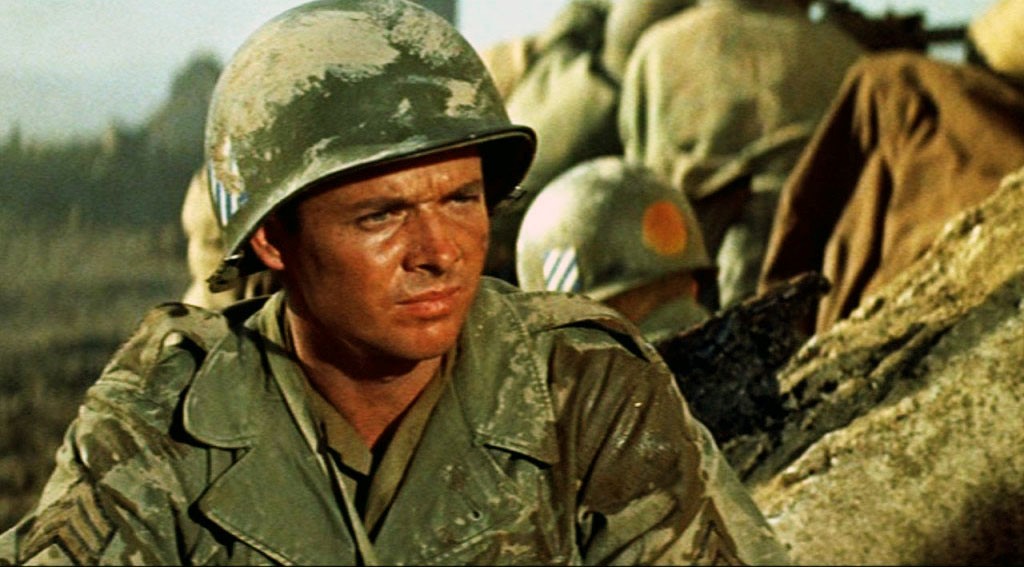
As the 3rd Division drove north into France, Murphy continued his outstanding performance in combat. On October 2, 1944, he earned a Silver Star for clearing a machine gun position near Cleurie Quarry. This was followed by a second Silver Star for advancing to direct artillery near Le Tholy. Recognizing Murphy’s competence as a combat leader, he was given a battlefield commission of 2nd Lieutenant and command of a rifle company.
On January 26, 1945, Audie Murphy and some 40 U.S. troops were tasked with holding a frigid snow-covered clearing around a roadway near the Alsatian town of Holtzwihr, awaiting promised reinforcements that were late in arriving. Just after mid-day, enemy artillery announced the arrival of at least 250 German troops and six Panzer tanks as they emerged from the woods.
Murphy had to quell once again a familiar sense of panic as the Germans lined up to attack, a mastery he had learned at the ripe young age of 19 during 18 months of bitter fighting across Italy and France. With two Silver Stars and the Distinguished Service Cross under his belt already, the baby-faced young Infantry Officer was leading men ten years his senior into battle. Once the shooting began, though, he knew his instincts would take over. “The nerves will relax,” he later wrote, “the heart, stop its thumping. The brain will turn to animal cunning. The job is directly before us: destroy and survive.”
Knowing that his men stood no chance against so large a force, he instructed them back to pre-prepared defensive positions along a nearby tree line. As they ran for cover, he stayed behind and used his field telephone to call in an artillery strike. He had just enough time to radio in his coordinates before German tank fire began delivering devastation around him and hit a nearby tank destroyer, which began burning.
Murphy Held his Ground and Continued Calling in the Allied Artillery
As the assault advanced, Murphy held his ground and continued calling in the Allied artillery. As his position became more precarious, he grabbed his field telephone and took cover atop the burning tank destroyer. Over the radio, he could hear the artillery commander asking how close the Germans were to his position. “Just hold the phone, and I’ll let you talk to one of the bastards!” he yelled back.
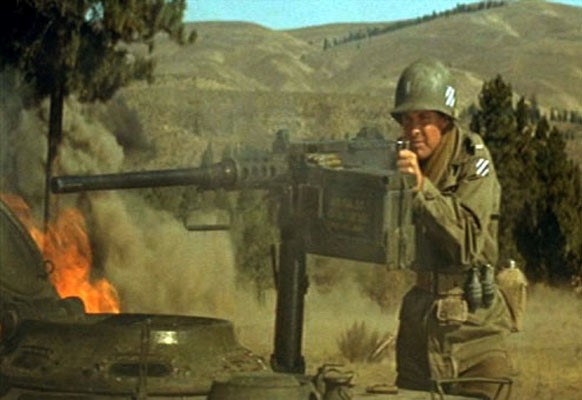
As the tank destroyer was slowly being engulfed in flames, Murphy saw that its .50-caliber machine gun turret was still operational and quickly seized the gun and began spraying the nearest German troops with withering fire. “My numbed brain is intent only on destroying,” Murphy later wrote in his autobiography. “I am conscious only that the smoke and the turret afford a good screen, and that, for the first time in three days, my feet are warm.” He continued firing burst after burst, mowing down Nazi troopers by the dozens and keeping the tanks at bay. All the while, he remained on the phone, directing artillery fire ever closer to his own position and dealing catastrophic damage to the advancing infantry.
Murphy’s troops watched in shock from their cover among the trees. “I expected to see the whole damn tank destroyer blow up under him any minute,” Private Anthony Abramski later wrote. In fact, the blaze provided a veil of smoke and flames that prevented the Germans from closing on his position out of fear that the vehicle was about to explode. Despite this, continuous waves of German Infantrymen inched toward Murphy’s position. A flanking maneuver on his right side was met with a hail of pinpoint fire from his .50-caliber gun. German gunners riddled his smoldering tank destroyer with small arms and tank fire. One blast nearly threw him out and sent razor-sharp shrapnel flying into his leg, but he ignored the wound and kept fighting. It was only when he ran out of ammunition that he finally withdrew. Dazed and bloodied, he jumped from the still-burning tank destroyer and limped back to his men. He later wrote that as he walked away, one thought in particular kept racing through his mind: “How come I’m not dead?”
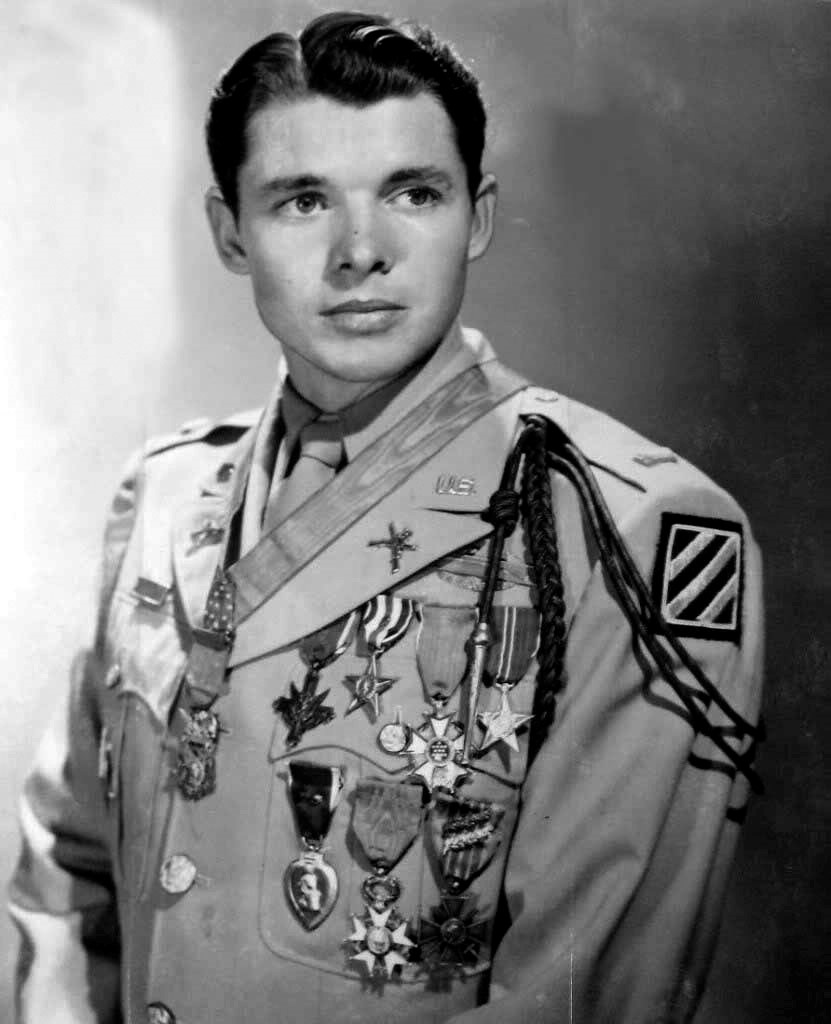
Audie Murphy was Hailed a National Hero and Awarded the Medal of Honor
It was the “greatest display of guts and courage I have ever seen,” a stunned Abramski later wrote. “For an hour, he held off the enemy force single-handed, fighting against impossible odds.” Murphy had personally killed or wounded some 50 enemy troops and directed artillery against dozens more. Even after reaching safety, he refused to be evacuated from the field and instead rallied his men in a counterattack that drove the Germans back into the woods.
Audie Murphy was hailed a national hero and awarded the Medal of Honor for his superhuman exploits at Holtzwihr. Not wanting to risk the life of its newest celebrity Soldier, the Army reassigned him as a Liaison Officer and removed him from combat. By the end of the war, a few months later, the battle-hardened G.I. had endured three wounds, a nasty case of malaria, gangrene, and more dead friends than he cared to remember. “There is VE-Day without,” he wrote of his mixed feelings at the war’s end, “but no peace within.”
In recognition of his overall performance between January 22, 1944, to February 18, 1945, Murphy also received the Legion of Merit. In May 1945, when victory was declared in Europe, he had still not reached his 21st birthday. Yet he had earned every military combat award for valor available from the U.S. Army, as well as French and Belgian awards for heroism.
Audie Murphy the Most-Decorated American Soldier of World War II
Hailed as the most-decorated American Soldier of World War II, Murphy returned home a hero and was greeted with parades and elaborate banquets. LIFE magazine honored the brave, baby-faced soldier by putting him on the cover of its July 16, 1945 issue. That photograph inspired actor James Cagney to call Murphy and invite him to Hollywood to begin an acting career. The two men, one a heroic actor and the other an acting hero, both short in stature but large in presence, hit it off.
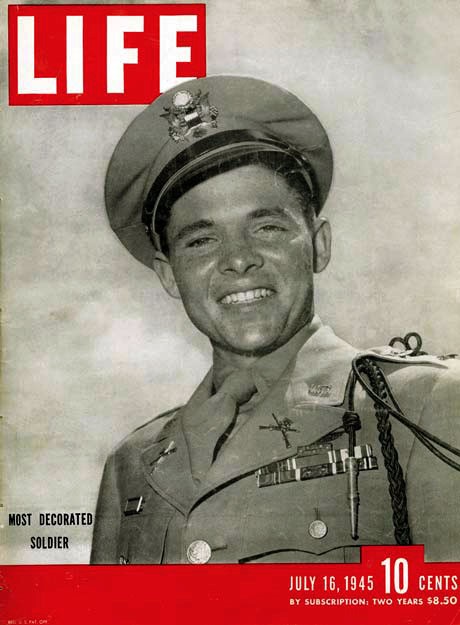
Removing his younger siblings from the orphanage, he took Cagney up on his offer, arriving in Hollywood with only his boyish good looks. However, despite his celebrity, for the next several years, he struggled to make it as an actor. Jobs were few, and he was only able to land just two bit parts: “Beyond Glory” (1948), and “Texas, Brooklyn & Heaven” (1948). He finally got a lead role in “Bad Boy” (1949), and earned critical acclaim for his starring role in Stephen Crane’s Civil War epic, “The Red Badge of Courage” (1951), directed by John Huston.
Murphy Published his Autobiography, “To Hell and Back.
In between movies, Murphy published his autobiography, “To Hell and Back.” The book quickly became a national bestseller, and in 1955, after much inner debate, he decided to portray himself in the film version of his book. The movie was a huge hit, setting a box-office record for Universal that wasn’t broken for 20 years until it was finally surpassed by “Jaws” (1975). One of his better pictures was “Night Passage” (1957), a Western in which he played the kid brother of James Stewart. He worked for Huston again on “The Unforgiven” (1960).

During his rise to fame, Murphy met and married 21-year-old actress Wanda Hendrix in 1949. Their marriage appeared rocky from the start, ending with a divorce in 1950. He then married former airline stewardess Pamela Archer, and they had two children: Terrance Michael “Terry” Murphy (born 1952) and James Shannon “Skipper” Murphy (born 1954).
In the 25 years that Audie spent in Hollywood, he made a total of 44 feature films. He also filmed a 26 episode western television series, known as “Whispering Smith,” which aired on NBC in 1961. Although the series earned good reviews, it was also characterized as unusually violent. Only 20 episodes were aired before the series was canceled.
Audie Murphy also wrote some poetry and was quite successful as a songwriter. One of his better-known poems is “The Crosses Grow on Anzio,” which appears in his autobiographical movie “To Hell and Back.” He also wrote a poem titled “Freedom Flies in Your Heart Like an Eagle,” which was part of a speech he gave at the July 20, 1968 dedication of the Alabama War Memorial in Montgomery, Alabama.

His songwriting talents were notable, as his penchant for country music and his poetic skill with rhyming and pentameter (a rhythmic syllabic pattern) resulted in many popular recordings. He usually teamed up with talented artists and composers such as Guy Mitchell, Jimmy Bryant, Scott Turner, Coy Ziegler, or Terri Eddleman. Dozens of Audie Murphy’s songs were recorded and released by such great performers as Dean Martin, Eddy Arnold, Charley Pride, Jimmy Bryant, Porter Waggoner, Jerry Wallace, Roy Clark, Harry Nilsson, and many, many others. His two biggest hits, both written in 1962 in collaboration with Scott Turner, were “Shutters and Boards,” which by the early ’70s was recorded in multiple languages by over 60 vocalists, and “When the Wind Blows in Chicago,” recorded by multiple artists including country artist Eddy Arnold on his 1993 RCA album “Last of the Love Song Singers.”
Despite his success in Hollywood, Audie never forgot his rural Texas roots. He frequently returned to the Dallas area, where he owned a small ranch for a while. He also had ranches in Perris, California, and near Tucson, Arizona. He was a successful Thoroughbred and Quarter Horse racehorse owner and breeder, having interests in such great horses as “Depth Charge.”
Always an advocate for the needs of veterans, he broke the taboo about discussing war-related mental problems after his experience. In an effort to draw attention to the problems of returning Korean and Vietnam War veterans, Audie Murphy was outspoken and candid about his personal problems with PTSD, then known as “Battle Fatigue.” He publicly called for the United States government to give more consideration and study to the emotional impact war has on veterans and to extend health care benefits to address PTSD and other mental health problems of returning war vets.
Murphy earned a great deal of money in his life as an actor and as part-owner of the Great Western Arms Company but also had a major gambling habit, which meant his finances were in a poor state for the last years of his life. One friend estimated Murphy lost $3 million through gambling. In 1968 his film career had dried up, and he declared bankruptcy. When he filed for bankruptcy, he stated that he lost $260,000 in an Algerian oil deal and was dealing with the Internal Revenue Service over unpaid taxes.
On May 28, 1971, Murphy was Killed in a Private Plane
On May 28, 1971, Murphy was killed when the private plane in which he was a passenger crashed into Brush Mountain, near Catawba, Virginia, 20 miles west of Roanoke in conditions of rain, clouds, fog, and zero visibility. The pilot and four other passengers were also killed. The aircraft was a twin-engine Aero Commander 680 flown by a pilot who had a private-pilot license and a reported 8,000 hours of flying time, but who held no instrument rating. The aircraft was recovered on May 31, 1971.
At the time of his death, major television news networks ABC, CBS, and NBC only gave him a combined total of 1 minute and 30 seconds of news.
In 1975, a court awarded Murphy’s widow and two children $2.5 million in damages due to the accident.
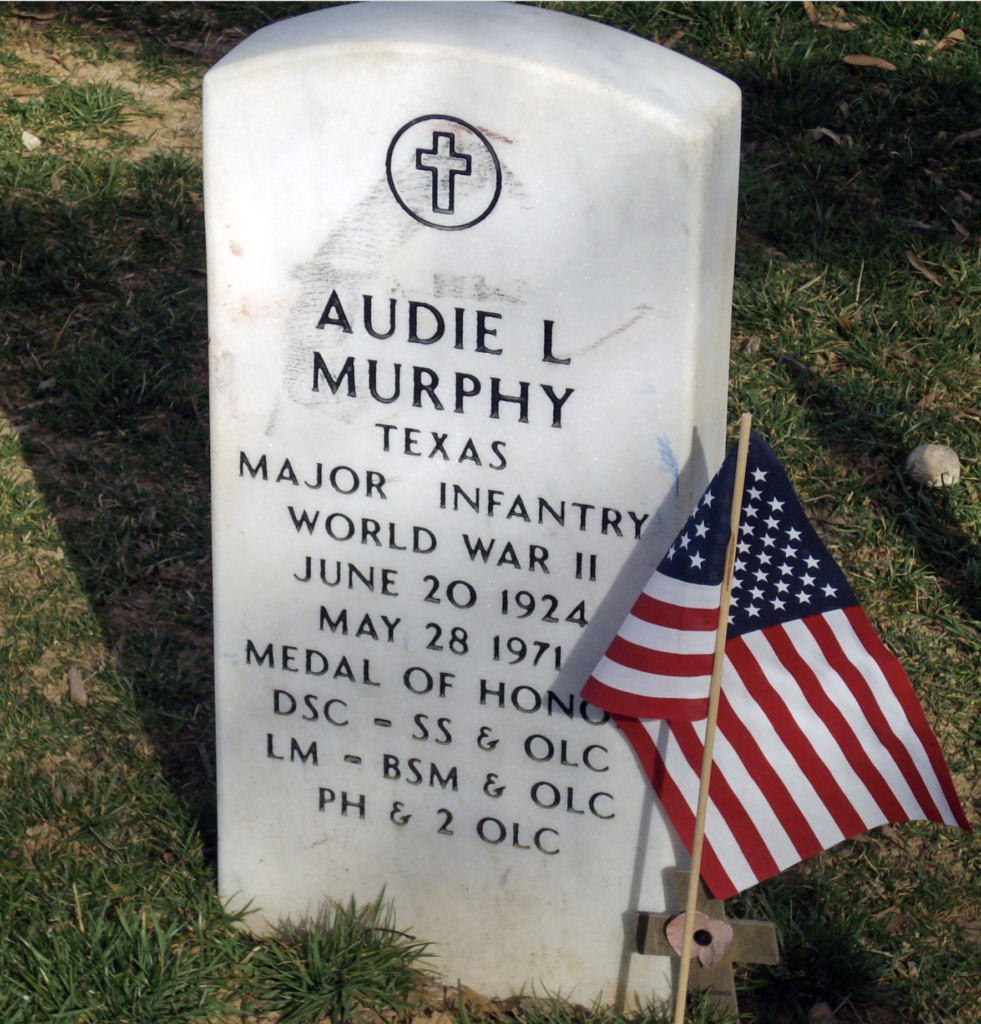
He is buried in Arlington National Cemetery, just across Memorial Drive from the Memorial Amphitheater. A special flagstone walkway has been constructed to accommodate the large number of people who stop to pay their respects to this hero. At the end of a row of graves, his tomb is marked by a simple, white, government-issue tombstone, which lists only a few of his many military decorations. The stone is, as he was, too small.
According to cemetery records, the only grave visited by more people than Murphy’s is that of assassinated President John F. Kennedy.
His widow, Pam Murphy, established her own distinctive thirty-five-year career working as a patient liaison at the Sepulveda Veteran’s Administration Hospital, treating every veteran who visited the facility as if they were a VIP. She remained working full time at the VA until 2007 when she was eighty-seven. She died peacefully at the age of 90 in her home in Canoga Park on April 8, 2010.
During Audie Murphy’s three years of active service as a combat Soldier in World War II, he became one of the best fighting men of this or any other century, earning 33 awards and decorations. What he accomplished during this period is most significant and probably will never be repeated by another soldier given today’s high-tech, stand-off type of warfare. The U.S. Army has always declared that there will never be another Audie Murphy.
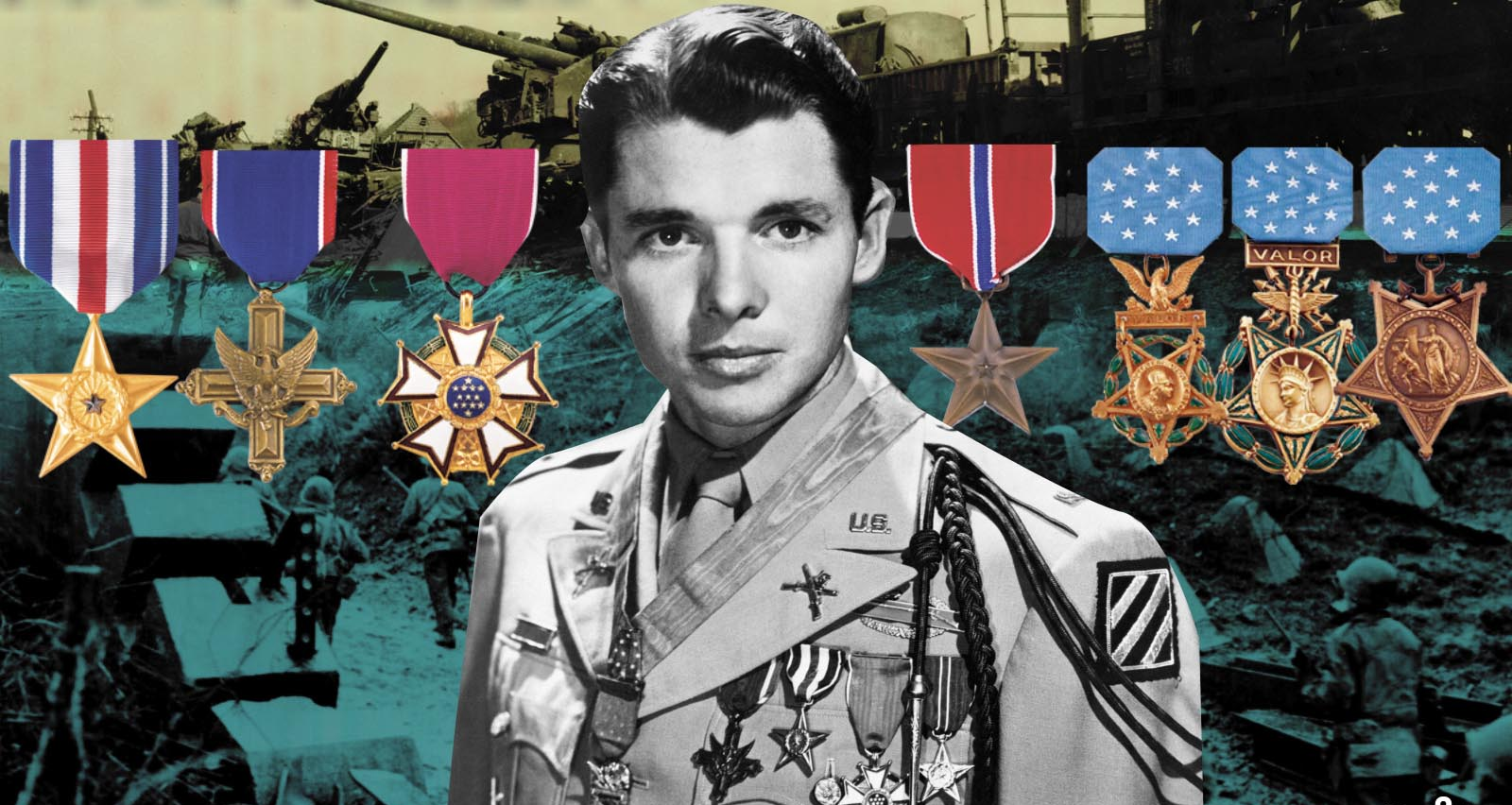
I am 83 years old now.My Father was in France in 1943 and was injured there.Like all the other solders hardly any thing was ever mentioned. We lived in Howard Co. Md in the early 1940s not to far from Ft. Meade army base.My father had worked at Ft.Meade as a carpenter before going to war. I can remember army machinery going past our house on maneuvers I was about 4 years old then. I also remember the German prisoners of war working on our neighbors farm.There is a chain of restaurants here and around the country that celebrate the solders and police departments in our area.They have hundreds of pictures on the walls to be remembered.
I was just reading some of AUDIE MURPHYS Bio.MY QUESTION IS – HOW DID THE ARMY GET SO MANY HEROS IN A 130 POUND BODY ???????? How can I get a picture of Audie Murphy to hang at our local Mission BBQ ?